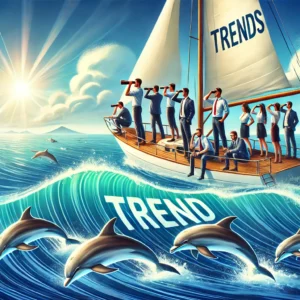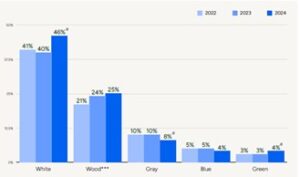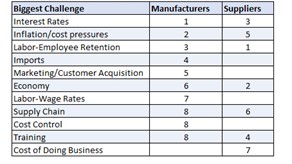
Setting or Following Construction Trends to Build Your Business
“Using Research to Maximize B2B Product Business Strategies”
| Check out the remaining segments of this six-part series |
|---|
| Part 1: Setting or Following Construction Trends to Build Your Business |
| Part 2: Cutting the B2B Gordian Knot |
| Part 3: Adopting an Anticipate, React, Adapt B2B Strategy |
| Part 4: Et Tu Trends? |
| Part 5: “Other” Factors Influencing What You Think Increases Sales |
| Part 6: “Other” Factors Influencing What You Think Decreases Sales. |
Predicting potential sales or the overall business outlook whether for a manufacturing company, a supplier or any company for that matter is not an easy task because doing it involves considering a myriad of economic, market, and industry-specific factors.
The complexity is because of the changes that occur frequently in all of those factors[1]; nothing much stays the same with the variables of the world wherein each business operates. This is especially true of trends operating in the “social media” world and the world at large. In other words, your decision to follow trends or create them will be based on “roving data.”
For example, fashion is one of those markets that creates trends at a clip. Historically, these trends were thought to follow a 20-year cycle, rising in popularity, fading, and then returning with a modern twist. However, the rise of social media and fast fashion[2] has condensed this cycle, with trends sometimes rising and falling in a matter of months. And while in B2B may be looked upon as more slow moving, the pace of economic data trends feeding product development has been increasing.
Social media influencers perhaps more than most can promote items or brands that go viral, leading to mass consumption. These “influencers” are not limited to what we think of as traditional influencers on Instagram; architectural firms, engineering firms themselves become influencers in terms of the specifications they create. Design and merchandising technologies have reduced the time it takes for trends to reach a market. Condensing time is a function of technology, and it also increases the amount of change in trends themselves.
Another example is social media in and of itself. Trends on social media seem to change daily, as content drives engagement, traffic, and conversions back and forth like a ping-pong match. For example, TikTok trends can last as little as 2–3 weeks. Trends in any industry – especially like B2B — may seem stagnant or circular in comparison (witness what’s happening with electrification in the HVAC industry). However, that perception is just that: a perception[3].
Sometimes, a type of cycle is repeated, giving the impression that “nothing changes.” In one case, an influencer or celebrity may write, “Traditional kitchens are moving out of fashion, open shelving taking their place.” Or, “white kitchens tend to be sterile and lacking personality. In reality, there is so much room to customize the space you spend the most time in.” Both are seeking to shape perceptions and not necessarily what you would call “reality.”
For example, the 2024 U.S. Houzz Kitchen Trends Study, indicated that 46% of the consumers surveyed preferred white cabinets—an increase of six percentage points from 2023 research. This supposedly proves that despite some perceptions on the market, that the trend of “white kitchens” is changing. White is still “in.” Or is it?

Source: 2024 U.S. Houzz Kitchen Trends Study | © Houzz Inc
Remember the trend toward automated faucets started years ago? And yet, you still have the majority of specifications are for manual faucets.
There are many reports out there that talk about product trends and can vary based on your search criteria. In fact, using artificial intelligence (AI) to find current research on the product trends for kitchens or housing or any other market, adds to the already-several different sources of research on trends.
Not only does Houzz publish several reports on trends, but other associations, research companies or organizations related to homes or kitchens publish information—National Kitchen and Bath Association (NKBA), National Home
Builders Association (NHBA), National Association of Realtors (NAR) are some of them. Even manufacturers themselves will publish information on what’s trending, as do the value-chain participants like architects.[4]
Keep in mind, basing your business strategy on trends alone is risky. While it’s important to know and understand what’s trending, there are other factors that affect the trends themselves which should be part of your business strategy calculations. You should at a minimum ask yourself if you follow or create these “trends.”
For example, Table One presents the ranking of how companies involved in the housing market answered a question: What do you see are the biggest challenges facing your business in 2024?
 Table One. Ranking of how respondents answered the question about the biggest challenges facing their business in 2024?
Table One. Ranking of how respondents answered the question about the biggest challenges facing their business in 2024?
Manufacturers see interest rates as their biggest challenge, while suppliers see labor and employee retention as the number one issue. In 2021, an Interline blog post – “77 Biggest Challenges in Business Today Boiled Down to One” showed us this:

Table Two: Results of compiling Google’s responses to the question, “What’s the biggest challenge in business today?”
There are some striking similarities (the importance of the “right” people in the jobs) between the past and the present. In fact, there doesn’t seem much that changes in terms of business challenges does it? Note, too, that “trends” itself is never mentioned as a factor influencing business strategies either in the past or the present surveys. Does that mean we should ignore them?
The question is actually what “trends” are going to help my business when it comes to overcoming these factors? Is there a trend that will do this, or do I have to create one? While an individual company doesn’t have control over interest rates, one company began competing with banks who do by offering their own terms to key accounts on purchases in volume. In short, different ways should be examined on using trends or creating them to help a business create a business strategy.
Our conclusion at that time and this was the root cause of all business problems was: finding and retaining customers. Without customers, there is no business. The question is, who is your customer?
That is still the conclusion today…but it’s also the problem: customers have splintered into a wider variety of “types” than ever before. So before deciding on which trends to follow or create and which to ignore in your business strategy, it is important to review customer fragmentation and these “new” targeted groups.
We would be happy to help you. Contact us, or read Part 2 in this series: Cutting the Gordian Knot. If you want a convenient of the entire series in one pdf file, email inquiries@a-i-m.com. Thanks for reading!
_____________________________________________________
[1] The Bureau of Labor Statics for example publishes preliminary estimates of employment, hours, and earnings about three weeks after a reference period, but then revises them twice, with the second preliminary estimate published the following month and the final estimate published two months after the initial release. If you watch this, your head will spin, and make strategy development difficult (i.e., in May 2024, BLS revised the number of job openings up by 90,000 to 8.2 million, but revised the number of hires down by 101,000 to 5.7 million).
[2] Fast fashion is a business model involving quickly manufacturing and selling inexpensive, trendy clothing that mimics popular styles. Fast fashion brands — H&M, Zara, or Shein, — often base collections on styles from Fashion Week, celebrities, and social media. The goal is to bring new looks to consumers at affordable prices while demand is high.
[3] Perception we know is a mental impression and a way of interpreting or understanding something. Reality is the state of things as they actually exist. We’ve heard the saying in advertising that “perception is reality,” and to a degree, that is especially true of trends. Perceptions are variables in people’s minds. These “perceptions” influenced by thoughts, feelings, experiences, interests, and actually how we process information (i.e., via social media, etc.). Trends are more perception then reality, and as such they are shaped by guiding individuals to view things in a particular way. This is what advertising (and influencers, and social media participants) try to do. Storytelling, word choice, images – these all shape perceptions and trends.
[4] Gensler’s DIALOGUE newsletter is an outstanding example of information on trending in various markets like education, municipal or industrial.